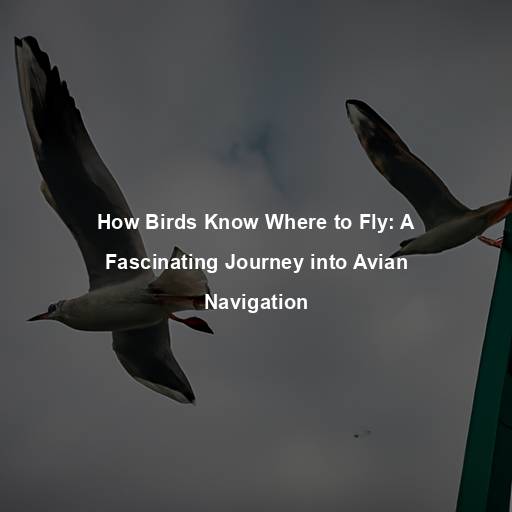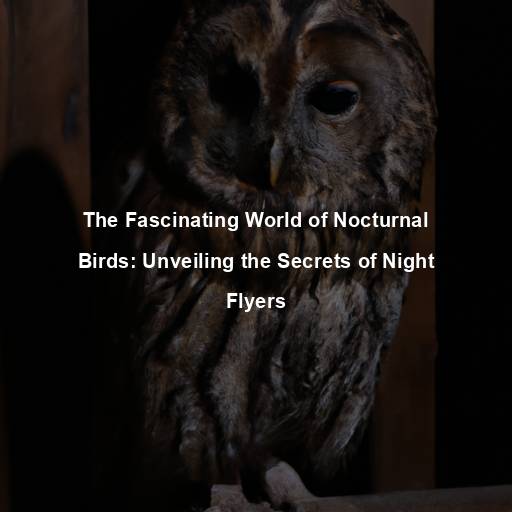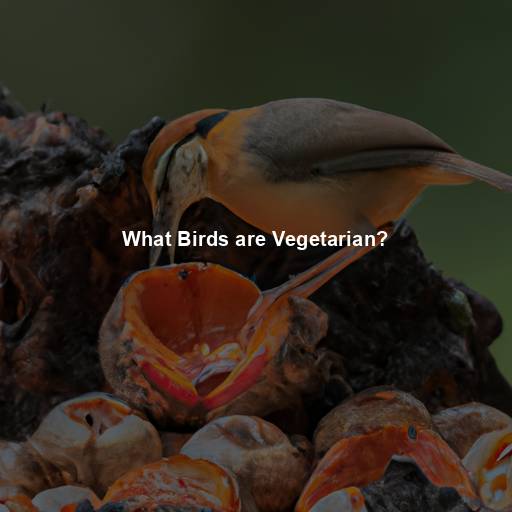How Birds Know Where to Fly: A Fascinating Journey into Avian Navigation
Last Updated on July 18, 2023 by Evan
Contents [hide]
- 1 Understanding the Inner Compass of Birds
- 2 Magnetic Sensitivity: The Compass Within
- 3 Celestial Navigation: Guided by the Stars
- 4 Environmental Cues: Reading the Signs
- 5 Innate Mapping: Genetic Predispositions
- 6 A Symphony of Navigation Techniques
- 7 Magnetic Disruptions: Navigating in a Changing World
- 8 Unsolved Mysteries: The Quest for Deeper Understanding
- 9 In Awe of Avian Navigation
- 10 Navigation Beyond Borders: Global Perspectives
- 11 Conservation and Preservation: Protecting Avian Navigation
- 12 The Never-Ending Journey of Discovery
- 13 FAQs – How Birds Know Where to Fly
Understanding the Inner Compass of Birds
From time immemorial, our imaginations have been held captive by the enigmatic world of birds, their extraordinary navigation skills, and their incomprehensible ability to traverse great expanses. The timeless wonder of Arctic Terns embarking on their migratory odyssey and the astounding homing instincts of pigeons have left us in a state of bewildered fascination. But alas, the perplexing question remains: How do these ethereal creatures decipher the daunting expanse of the heavens and navigate through it with impeccable accuracy? Brace yourself for a mesmerizing expedition as we embark on a quest to unravel the labyrinthine enigmas of avian navigation.
Magnetic Sensitivity: The Compass Within
The Earth’s Magnetic Field
Birds possess an impressive knack for navigation, largely attributed to their intriguing ability to detect the Earth’s magnetic field. Recent research has unveiled the presence of specialized iron-rich cells, known as magnetoreceptors, in the beaks and eyes of certain avian species. The intricate interplay between these cells and the surrounding magnetic field allows birds to skillfully interpret and utilize this ethereal guidance system, serving as an internal compass for their journeys across the skies.
Magnetite: A Magnetic Mineral
Researchers believe that magnetite, a magnetic mineral found in the bodies of certain bird species, plays a significant role in their ability to sense the Earth’s magnetic field. It is thought that magnetite particles align themselves with the magnetic lines of force, providing birds with a tangible sense of direction. While the exact mechanisms are still being studied, the presence of magnetite in birds hints at the fascinating ways in which they perceive the world.
Stellar Constellations
Did you know that birds possess an uncanny ability to navigate through the vastness of the sky? It’s not just their magnetic sensitivity that gives them this power, but also their reliance on celestial cues. By looking up at the stars, these feathered creatures can decipher their direction, especially when they embark on long migratory journeys. Imagine having the night sky as your map – that’s exactly what these birds do, following the stellar constellations and staying on course towards their desired destination.
It’s truly mind-boggling how birds are able to tap into the mesmerizing power of polarized light. This incredible phenomenon aids them in their grand celestial navigation quests. Picture this: as rays of sunlight dance through the atmosphere, they transform into this distinct polarized pattern. And guess what?
Environmental Cues: Reading the Signs
Landmarks and Landforms
Birds are keen observers of their environment, and they rely on various visual cues to navigate effectively. Landmarks such as mountains, coastlines, and rivers serve as reliable reference points for many bird species. By memorizing these features during their initial journeys, birds can navigate back to their breeding grounds or wintering sites with remarkable accuracy.
In the vast realm of avian navigation, one intriguing avenue remains shrouded in mystery – the enigmatic world of olfactory cues. While often overlooked, whispers of scientific investigations hint at the possibility that certain bird species possess an extraordinary ability to track scent trails, especially during their awe-inspiring migratory journeys. Astoundingly, it is postulated that birds possess a finely-tuned olfactory system, capable of detecting infinitesimal amounts of chemicals lingering in the air, guiding them towards bountiful food sources or hospitable havens. As we delve deeper into their aromatic realm, the perplexing yet captivating relationship between our feathered friends and olfaction comes to the forefront, illuminating the remarkable complexity of avian navigation.
Innate Mapping: Genetic Predispositions
Genetic Programming
Bird navigation is a magnificent enigma that goes beyond mere learning or experience. Astonishing research uncovers the hidden secrets in birds’ genes, revealing that specific genetic markers play a crucial role in guiding them on their epic migratory journeys. These genetic predispositions act as the mystical compass that shapes the foundation of their navigation skills, unfolding a mesmerizing tapestry of nature’s design.
Imprinting and Learning
While genetics play a significant role, birds also learn and refine their navigation skills through a process called imprinting. During the critical early stages of development, young birds imprint on their surroundings, memorizing important landmarks and environmental cues. This imprinting process helps them navigate successfully during their first migratory journeys and sets the stage for their future navigation abilities.
Birds possess a remarkable array of navigation techniques that intertwine in mesmerizing ways, guiding them through vast distances with a mysterious grace. From harnessing the magnetic compass’s power on cloudy days to following celestial cues to chart their migration routes, these avian marvels have developed an intricate navigation system that confounds and captivates both scientists and bird enthusiasts. Delving into the intricacies of these avian navigators never fails to unlock endless wonder and perplexity surrounding their incredible journeys.
It is truly awe-inspiring how birds effortlessly traverse vast distances, defying our understanding of navigation in the natural realm. Their uncanny ability to perceive the Earth’s magnetic fields, interpret celestial clues, and decipher environmental cues is simply mind-boggling. With each revelation about their genetic predispositions and the amalgamation of various techniques, we are left even more perplexed by the sheer audacity with which birds navigate through the endless skies. These tireless travelers fuel our curiosity, fostering a deeper reverence for the intricate wonders of the natural world.
Note: This essay continues in the next response.## The Role of Experience: Learning from the Elders
Social Learning
Birds, enchanting creatures of the skies, possess an innate fascination with social connections. It is within these intricate networks that they unravel the secrets of navigation, an essential skill for their arduous migratory sojourns. The inexperienced, wide-eyed fledglings stumble upon a treasure trove of wisdom as they witness the seasoned aviators in action, embracing the unspoken lessons that lead them towards a path of triumphant flight. Through mirroring their elders, these neophytes unlock the realms of heightened dexterity and unwavering precision, embarking on their maiden voyage with newfound grace and purpose.
Route Learning
Birds, particularly those like homing pigeons, possess an awe-inspiring talent for memorizing intricate routes with uncanny precision. By embarking on countless journeys between well-known destinations, these feathered navigators gradually construct an elaborate mental map of the terrain, enabling them to effortlessly identify vital landmarks as they traverse their path. This remarkable skill empowers them to navigate smoothly, defying the odds when faced with the absence of other customary cues.
Challenges of Man-Made Structures
While birds have adapted to navigate the natural world, they face new challenges in an increasingly human-altered environment. Modern structures, such as tall buildings and communication towers, can disrupt the Earth’s magnetic field, potentially disorienting birds that rely on magnetic cues for navigation. This interference highlights the need for careful urban planning to minimize the impact on avian navigation.
When the stars are out, birds rely on their celestial GPS to find their way. But with the excessive artificial lighting in cities, their celestial navigation is thrown into disarray. The bright city lights play hide-and-seek with the constellations, leaving our feathered friends feeling perplexed and bewildered. To prevent them from getting lost, it’s crucial to safeguard the darkness of the night sky, giving our avian aviators a fighting chance to reach their destination.
Unsolved Mysteries: The Quest for Deeper Understanding
Quantum Biology: A Revolutionary Approach
As scientists continue to explore the intricacies of bird navigation, new avenues of research are emerging, including the field of quantum biology. Quantum phenomena, such as quantum entanglement, have been proposed as potential mechanisms for explaining how birds sense the Earth’s magnetic field. This groundbreaking approach challenges our understanding of the natural world and opens up exciting possibilities for unraveling the mysteries of avian navigation.
While many aspects of bird navigation are well understood, there is still much to learn about the individual variability in navigational strategies. Some birds may rely more heavily on magnetic cues, while others prioritize celestial navigation or environmental landmarks. Understanding the factors that contribute to these variations will provide valuable insights into the complex world of avian navigation.
As we embark on our exploration of the captivating world of bird navigation, we are left in awe of the astonishing prowess these aerial beings possess. From their perplexing ability to sense Earth’s magnetic fields and navigate by the stars above, to their intuitive reliance on the clues scattered throughout their surroundings and the underlying genetic underpinnings, birds have crafted an intricate and wondrous system to traverse the expansive heavens. Prepare to be captivated by the burst of knowledge as we unravel the enigma of avian navigation.
The fascinating realm of avian navigation continues to bewilder and captivate scientists, as we delve deeper into the intricate mysteries that lie within. The enigmatic ways in which birds navigate through the vast expanses of our planet serve as a perplexing reminder of the concealed wonders that nature has in store for us. As we strive to unravel the secrets of their extraordinary journeys, it becomes increasingly evident that climate change poses a formidable challenge to avian navigation. This impending obstacle calls upon us to appreciate and study the remarkable skills of our feathered friends, while also igniting a spark within us to venture into uncharted territories in search of solutions to this pressing conundrum.
Altered Migration Patterns
The shifting climate throws migratory birds into a whirlwind of uncertainty, presenting them with formidable obstacles. As temperatures fluctuate and weather patterns go haywire, these magnificent creatures find themselves perplexed, struggling to time their migrations flawlessly. The already daunting feat of crossing vast distances is made even more arduous by the inconsistent availability of food and alterations in their once-familiar habitats along their designated routes. Adaptation becomes the name of the game as avian nomads grapple with the need to recalibrate their navigation strategies and chart unprecedented paths towards their desired destinations.
Shifted Breeding Grounds
As temperatures soar and nature’s delicate balance seems to fluctuate, the avian world must adapt to survive. A bewildering puzzle emerges as traditional breeding sanctuaries lose their luster, compelling these resilient creatures to seek unfamiliar grounds for their offspring’s future. And so, with graceful determination, birds embark on a voyage of discovery, their innate navigation prowess challenged amidst the perplexing web of uncertainty.
Long-Distance Migrations
Birds embark on some of the most awe-inspiring journeys known to us. From the Arctic Tern’s annual migration from the Arctic to the Antarctic, spanning over 44,000 miles, to the incredible journeys of songbirds crossing continents, these long-distance migrations showcase the remarkable navigational abilities of birds. These journeys transcend borders, reminding us of the interconnectedness of ecosystems and the need for international collaboration in preserving their habitats.
Cultural Significance
Across diverse societies, the enigmatic flight of birds and their migratory patterns exudes a captivating allure. Embedded within their ethereal journeys lies a cornucopia of cultural symbolism, weaving a tapestry encompassing folklore, artistic expressions, and profound spiritual beliefs. The hallowed reverence bestowed upon the ibis by ancient Egyptians, intertwined with the mystical allure of the crane in various Asian cultures, illustrates the profound impact of birds’ navigational prowess on the kaleidoscope of human civilization. Embracing the enigmatic essence of avian migration, these winged beings continue to beguile and mystify, leaving an indelible imprint on our collective consciousness.
Habitat Conservation
Preserving the habitats that support birds’ navigation is crucial for their survival. Protecting wetlands, forests, and other critical ecosystems helps ensure that birds have the necessary resources and landmarks to navigate successfully. Conservation efforts should focus on maintaining the integrity of these habitats, reducing habitat fragmentation, and minimizing the impact of human activities.
Reducing Light Pollution
In a world where birds rely on the stars to guide their path, the battle against light pollution becomes crucial. Our concrete jungles must embrace responsible lighting practices to offer these avian travelers a fighting chance. By shielding lights, embracing motion sensors, and advocating for dark sky initiatives, we can create a harmonious coexistence where birds soar through the night with confidence and grace. Let’s navigate their celestial needs and pave a brighter future for their journey.
The Never-Ending Journey of Discovery
As our fascinating journey into the realm of bird navigation draws to a close, it becomes abundantly clear that this captivating subject is a riddle wrapped in a mystery, shrouded in awe-inspiring complexity. Despite our commendable strides in unraveling the enigmatic abilities of our feathered friends, the quest for knowledge within this field knows no bounds. Every revelation only serves to ignite a newfound fervor for understanding the intricacies that permit birds to traverse our world with astonishing precision and grace. With each door opened, a labyrinth of queries beckons, leaving us both baffled and spellbound by the unfathomable mechanisms that underlie avian navigation.
In a world filled with awe-inspiring mysteries, let us not forget to tune into the astonishing tales of avian migration. These extraordinary creatures have mastered the art of soaring through the skies, leaving us in a state of utter bewilderment. As they embark on their epic journeys, they paint a striking tableau of the enduring power and splendor of nature. It is our responsibility, fueled by this perplexing marvel, to join hands in safeguarding their habitats and nurturing the miracles that unfold in their flight.
In the ever-unfolding symphony of existence, the avian creatures gracefully navigate through the celestial vastness, serving as a profound reminder that amidst the bewildering chaos and ceaseless transformations of our world, there exists a steady path towards progress and evolution.
FAQs – How Birds Know Where to Fly
How do birds know where to migrate?
The marvel of avian migration is a perplexing spectacle, shrouded in a veil of bewilderment that continues to baffle scientists and enthusiasts alike. Birds, with their awe-inspiring innate capabilities, embark on extraordinary journeys spanning vast distances. Bursting with an uncanny sense of direction, these feathered navigators rely on a medley of factors to guide their way through the endless skies. Their sharp vision serves as their guiding compass, enabling them to glean celestial cues from the sun and stars, particularly on cloudless days. Yet, their reliance on sight alone hardly tells the full story. These avian wayfarers also instinctively harness environmental cues, effortlessly identifying landmarks, coastlines, and mountain ranges that act as faithful markers along their migration routes. But the intrigue does not end there. Birds possess an enigmatic ability to tap into the Earth’s magnetic field, utilizing specialized cells in their eyes as magnetic sensors. This extraordinary faculty allows them to navigate, unhindered by cloudy skies or the shroud of darkness that blankets their nocturnal escapades. Scientists postulate that it is the seamless integration of these diverse sources of information that grants birds the remarkable aptitude to navigate and stay on course during their arduous long-distance journeys.
Do birds use the same routes each year?
Birds, like humans, are not always creatures of habit when it comes to their migration routes. While some species do exhibit steadfast loyalty to their chosen paths, many birds actually possess a surprising amount of adaptability. Various factors, such as weather patterns, food availability, and past breeding success, influence their decision-making process. These avian travelers may opt for alternative routes to take advantage of favorable winds or steer clear of unfavorable weather conditions, consequently ensuring a smoother and safer passage. Furthermore, the ever-changing distribution and accessibility of food sources along their migratory paths may prompt these feathered wanderers to adjust their routes in search of sustenance. Ultimately, although many birds stick to their tried-and-true paths, their flexibility grants them the ability to embrace change based on prevailing circumstances.
How do birds find their way in unfamiliar areas?
When birds encounter unfamiliar areas during migration, they employ a variety of strategies to navigate and find their way. One of the main mechanisms they utilize is called “piloting,” which involves using visual landmarks or distinct features of the landscape to guide their route. These landmarks can include rivers, mountains, coastlines, or even man-made structures like buildings or roads. By memorizing and recognizing the unique features of a particular area, birds are able to establish mental maps and navigate accordingly. Additionally, birds may also rely on the position of the sun or stars during clear skies, as well as their internal magnetic compass, to maintain a general sense of direction. While birds may initially rely on instincts and genetic programming for migration, they also possess the ability to learn from previous experiences, allowing them to adapt and navigate successfully in unfamiliar territories.
Can birds get lost during migration?
Despite their exceptional navigational abilities, birds can occasionally get disoriented or temporarily lost during migration. This can occur due to various factors, such as severe weather events, unexpected changes in wind patterns, or disturbances caused by human activities. In some cases, these navigational disturbances can lead birds off their intended migratory path, resulting in them becoming temporarily lost. However, birds possess resilience and the capacity to correct their course by relying on backup navigational cues, obtaining visual references, or adjusting their flight patterns. It is essential to remember that getting lost during migration is a natural occurrence for birds and they have evolved survival mechanisms to overcome such situations.
How do young birds learn their migration routes?
Young birds typically learn their migration routes through a combination of innate behavior and social learning. Juvenile birds often join their parents or other experienced members of their species during their first migratory journey, enabling them to follow and learn from the experienced individuals. This process is known as “imprinting,” where the young birds acquire essential information regarding route selection, stopover locations, and other navigational cues from the experienced individuals. Additionally, as young birds gain more independent migration experience, they further refine their navigational skills through trial-and-error learning and by integrating innate navigational abilities. It is a combination of genetic programming, social learning, and individual learning that aids young birds in successfully learning and completing their migration routes.







